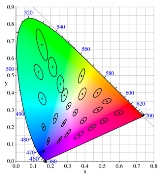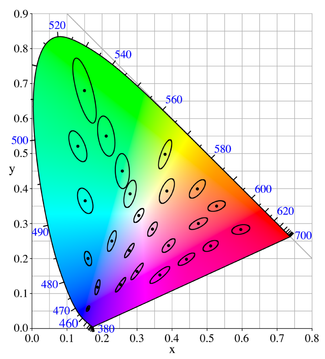
Color difference
Encyclopedia
The difference or distance between two colors is a metric
of interest in color science. It allows people to quantify a notion that would otherwise be described with adjectives, to the detriment of anyone whose work is color critical. Common definitions make use of the Euclidean distance
in a device independent
color space
.
(CIE) calls their distance metric ΔE*ab (also called ΔE*, dE*, dE, or “Delta E”) where delta
is a Greek letter often used to denote difference, and E stands for Empfindung; German for "sensation". Use of this term can be traced back to the influential Hermann von Helmholtz
and Ewald Hering
.
In theory, a ΔE of under 1.0 is supposed to be indistinguishable unless the samples are adjacent to one another. However, perceptual non-uniformities in the underlying CIELAB color space prevent this and have led to the CIE's refining their definition over the years. These non-uniformities are important because the human eye is more sensitive to certain colors than others. A good metric should take this into account in order for the notion of a "just noticeable difference
" to have meaning. Otherwise, a certain ΔE that may be insignificant between two colors that the eye is insensitive to may be conspicuous in another part of the spectrum.
 and
and  , two colors in L*a*b*:
, two colors in L*a*b*:

 corresponds to a JND (just noticeable difference).
corresponds to a JND (just noticeable difference).
ΔE (1994) is defined in the L*C*h* color space with differences in lightness, chroma and hue calculated from L*a*b* coordinates. Given a reference color and another color
and another color  , the difference is:
, the difference is:

where:







and where the weighting factors K depend on the application:











defined a difference measure, also based on the L*C*h color model. Named after the developing committee, their metric is called CMC l:c. The quasimetric has two parameters: lightness (l) and chroma (c), allowing the users to weight the difference based on the ratio of l:c that is deemed appropriate for the application. Commonly-used values are 2:1 for acceptability and 1:1 for the threshold of imperceptibility.
The distance of a color to a reference
to a reference  is:
is:



CMC l:c is designed to be used with D65 and the CIE Supplementary Observer.
 Tolerancing concerns the question "What is a set of colors that are imperceptibly/acceptably close to a given reference?" If the distance measure is perceptually uniform, then the answer is simply "the set of points whose distance to the reference is less than the just-noticeable-difference (JND) threshold." This requires a perceptually uniform metric in order for the threshold to be constant throughout the gamut
Tolerancing concerns the question "What is a set of colors that are imperceptibly/acceptably close to a given reference?" If the distance measure is perceptually uniform, then the answer is simply "the set of points whose distance to the reference is less than the just-noticeable-difference (JND) threshold." This requires a perceptually uniform metric in order for the threshold to be constant throughout the gamut
(range of colors). Otherwise, the threshold will be a function of the reference color—useless as an objective, practical guide.
In the CIE 1931 color space
, for example, the tolerance contours are defined by the MacAdam ellipse
, which holds L* (lightness
) fixed. As can be observed on the diagram on the right, the ellipse
s denoting the tolerance contours vary in size. It is partly due to this non-uniformity that lead to the creation of CIELUV and CIELAB.
More generally, if the lightness is allowed to vary, then we find the tolerance set to be ellipsoidal. Increasing the weighting factor in the aforementioned distance expressions has the effect of increasing the size of the ellipsoid along the respective axis.
Metric (mathematics)
In mathematics, a metric or distance function is a function which defines a distance between elements of a set. A set with a metric is called a metric space. A metric induces a topology on a set but not all topologies can be generated by a metric...
of interest in color science. It allows people to quantify a notion that would otherwise be described with adjectives, to the detriment of anyone whose work is color critical. Common definitions make use of the Euclidean distance
Euclidean distance
In mathematics, the Euclidean distance or Euclidean metric is the "ordinary" distance between two points that one would measure with a ruler, and is given by the Pythagorean formula. By using this formula as distance, Euclidean space becomes a metric space...
in a device independent
Device independent
A program or file is device independent when its function is universal on different types of device.For the World Wide Web, this means writing simple common denominator Hypertext Markup Language and Cascading Style Sheets so that most Web user agents on most devices can render it acceptably.For...
color space
Color space
A color model is an abstract mathematical model describing the way colors can be represented as tuples of numbers, typically as three or four values or color components...
.
Delta E
The International Commission on IlluminationInternational Commission on Illumination
The International Commission on Illumination is the international authority on light, illumination, color, and color spaces...
(CIE) calls their distance metric ΔE*ab (also called ΔE*, dE*, dE, or “Delta E”) where delta
Delta (letter)
Delta is the fourth letter of the Greek alphabet. In the system of Greek numerals it has a value of 4. It was derived from the Phoenician letter Dalet...
is a Greek letter often used to denote difference, and E stands for Empfindung; German for "sensation". Use of this term can be traced back to the influential Hermann von Helmholtz
Hermann von Helmholtz
Hermann Ludwig Ferdinand von Helmholtz was a German physician and physicist who made significant contributions to several widely varied areas of modern science...
and Ewald Hering
Ewald Hering
Karl Ewald Konstantin Hering was a German physiologist who did much research into color vision and spatial perception...
.
In theory, a ΔE of under 1.0 is supposed to be indistinguishable unless the samples are adjacent to one another. However, perceptual non-uniformities in the underlying CIELAB color space prevent this and have led to the CIE's refining their definition over the years. These non-uniformities are important because the human eye is more sensitive to certain colors than others. A good metric should take this into account in order for the notion of a "just noticeable difference
Just noticeable difference
In psychophysics, a just noticeable difference, customarily abbreviated with lowercase letters as jnd, is the smallest detectable difference between a starting and secondary level of a particular sensory stimulus...
" to have meaning. Otherwise, a certain ΔE that may be insignificant between two colors that the eye is insensitive to may be conspicuous in another part of the spectrum.
CIE76
Using and
and  , two colors in L*a*b*:
, two colors in L*a*b*:
 corresponds to a JND (just noticeable difference).
corresponds to a JND (just noticeable difference).CIE94
The 1976 definition was extended to address perceptual non-uniformities, while retaining the L*a*b* color space, by the introduction of application-specific weights derived from an automotive paint test's tolerance data.ΔE (1994) is defined in the L*C*h* color space with differences in lightness, chroma and hue calculated from L*a*b* coordinates. Given a reference color
 and another color
and another color  , the difference is:
, the difference is:
where:







and where the weighting factors K depend on the application:
| graphic arts | textiles | |
|---|---|---|
 |
1 | 2 |
 |
0.045 | 0.048 |
 |
0.015 | 0.014 |
CIEDE2000
Since the 1994 definition did not adequately resolve the perceptual uniformity issue, the CIE refined their definition, adding five corrections:- A hue rotation term (RT), to deal with the problematic blue region (hue angles in the neighborhood of 275°):
- Compensation for neutral colors (the primed values in the L*C*h differences)
- Compensation for lightness (SL)
- Compensation for chroma (SC)
- Compensation for hue (SH)











CMC l:c (1984)
In 1984, the Colour Measurement Committee of the Society of Dyers and ColouristsSociety of Dyers and Colourists
The Society of Dyers and Colourists is an international professional society, with headquarters in Bradford, United Kingdom, specializing in colour in all its manifestations. Founded in 1884, it was granted a Royal Charter of Incorporation in 1963...
defined a difference measure, also based on the L*C*h color model. Named after the developing committee, their metric is called CMC l:c. The quasimetric has two parameters: lightness (l) and chroma (c), allowing the users to weight the difference based on the ratio of l:c that is deemed appropriate for the application. Commonly-used values are 2:1 for acceptability and 1:1 for the threshold of imperceptibility.
The distance of a color
 to a reference
to a reference  is:
is:


CMC l:c is designed to be used with D65 and the CIE Supplementary Observer.
Tolerance

Gamut
In color reproduction, including computer graphics and photography, the gamut, or color gamut , is a certain complete subset of colors. The most common usage refers to the subset of colors which can be accurately represented in a given circumstance, such as within a given color space or by a...
(range of colors). Otherwise, the threshold will be a function of the reference color—useless as an objective, practical guide.
In the CIE 1931 color space
CIE 1931 color space
In the study of color perception, one of the first mathematically defined color spaces is the CIE 1931 XYZ color space, created by the International Commission on Illumination in 1931....
, for example, the tolerance contours are defined by the MacAdam ellipse
MacAdam ellipse
In the study of color vision, MacAdam ellipses refer to the region on a chromaticity diagram which contains all colors which are indistinguishable, to the average human eye, from the color at the center of the ellipse...
, which holds L* (lightness
Lightness (color)
Lightness is a property of a color, or a dimension of a color space, that is defined in a way to reflect the subjective brightness perception of a color for humans along a lightness–darkness axis. A color's lightness also corresponds to its amplitude.Various color models have an explicit term for...
) fixed. As can be observed on the diagram on the right, the ellipse
Ellipse
In geometry, an ellipse is a plane curve that results from the intersection of a cone by a plane in a way that produces a closed curve. Circles are special cases of ellipses, obtained when the cutting plane is orthogonal to the cone's axis...
s denoting the tolerance contours vary in size. It is partly due to this non-uniformity that lead to the creation of CIELUV and CIELAB.
More generally, if the lightness is allowed to vary, then we find the tolerance set to be ellipsoidal. Increasing the weighting factor in the aforementioned distance expressions has the effect of increasing the size of the ellipsoid along the respective axis.
External links
- Mauro Boscarol color difference calculator. Implementation in Adobe AIR
- Bruce Lindbloom's color difference calculator. Uses all metrics defined herein.
- The CIEDE2000 Color-Difference Formula, by Gaurav Sharma. Implementations in MATLAB and Excel.
- Color Similarity Tool, by Dragan Bajcic, Implementations in PHP and Javascript.
- python-colormath. Implementation in Python.
- Precise Color Communication Konica Minolta Sensing.

